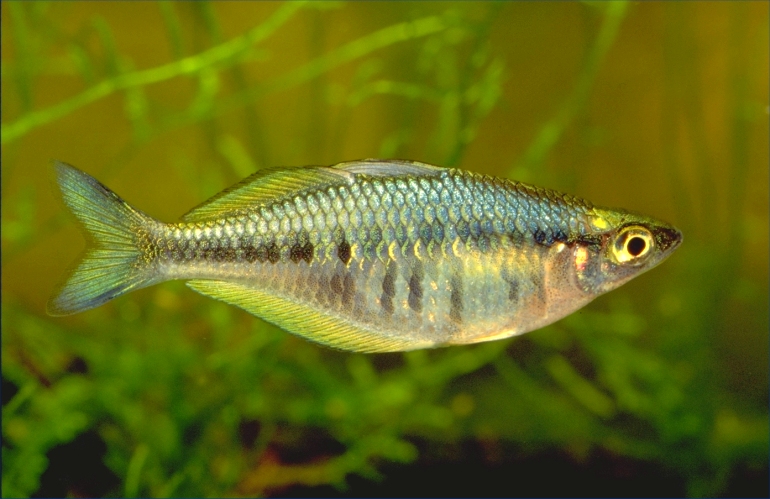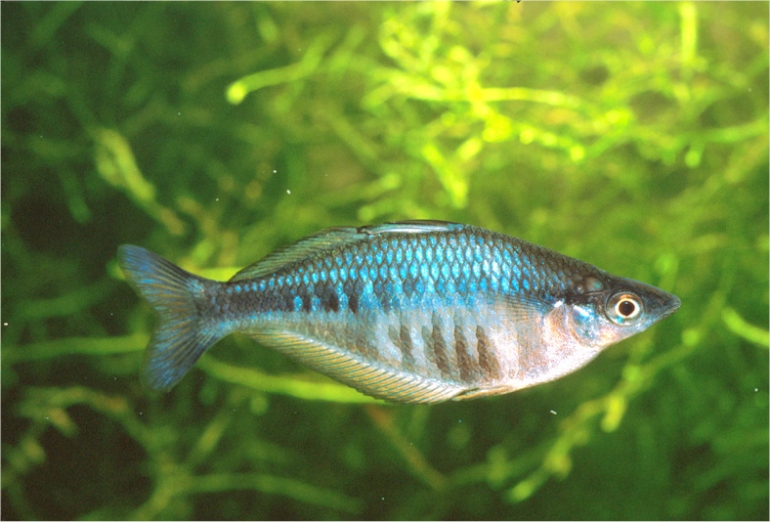|
 |
Chilatherina axelrodi - photo© Neil Armstrong |
Allen, 1980
Axelrods Rainbowfish
Species Summary
Chilatherina axelrodi males have a body colour of bluish-grey to greenish-brown on the upper half of the body and silver-grey or whitish on the lower half. There is a about 10 short bars along the middle of side (approximately every two scales) that finally merge with a more or less solid blackish stripe along the middle of caudal peduncle. There are about 6-10 faint dusky bars on lower side of the body, those on side of abdomen are particularly evident. The upper half of the body has a number of bluish stripes while the lower half has a number of faint yellow stripes, bordering each longitudinal scale row. The dorsal, anal and pelvis fins are yellowish, other fins translucent. Females are an overall silvery colour and rather plain compared to the males. Males are more brightly coloured, larger, and much deeper bodied than females. Males may reach a maximum size of 10 cm, with females usually less than 8 cm SL. Spawning usually occurs from October to January, with females producing between 50 and 150 eggs, spawning over a period of several days.
Distribution & Habitat
Chilatherina axelrodi were first collected in 1979 from Yungkiri Creek, a tributary of the Pual River (formerly Nemayer or Neumayer River), in the Bewani Mountains of Papua New Guinea. This location is about 40 kilometres inland from the north-coast town of Vanimo, which is close to the West Papuan border. Vanimo is a relatively recent township; it was established as a patrol post and then abandoned and reoccupied several times during the Australian administration. Only after the Sepik district was divided into east and west in 1967, Vanimo became the capital of what was then the West Sepik District and today is the Sandaun Province. Sandaun Province is the north-westernmost province of Papua New Guinea. It covers an area of 36,300 km².
Chilatherina axelrodi were found around sub-surface vegetation, submerged logs and branches in a small, narrow slow flowing rainforest stream. The water at the collection site was slightly turbid and a temperature of 28°C and pH 7.8 were recorded. Other rainbowfishes found in the stream included Chilatherina crassispinosa and Melanotaenia affinis. Chilatherina fasciata and Chilatherina lorentzi have also been collected from the Paul River.
 |
Chilatherina axelrodi - photo© Neil Armstrong |
Remarks
A number of live specimens were collected by Gerald Allen, Brian Parkinson and Peter Neusinger in September 1979, but unfortunately they all died soon after arriving in Australia. However, Gerry Allen returned in 1982 and together with Heiko Bleher they collected more live specimens, which were later bred and distributed in the hobby. In 1983 further live specimens were collected by Barry Crockford and returned to Australia. Although a rather attractive species, it has never achieved much popularity in the hobby, and could be considered rare. The species was named in honour of Herbert R. Axelrod who provided funding for the first collecting expedition.
Literature
Allen G.R. (1980) Chilatherina axelrodi, A New Species of Rainbowfish (Melanotaeniidae) From Papua New Guinea. Tropical Fish Hobbyist 28 (5): 48-55.
Allen G.R. (1981) A revision of the rainbowfish genus Chilatherina (Melanotaeniidae). Record of the Western Australian Museum 9(3): 279-299.
Adrian R. Tappin
Updated August, 2015



|
|

